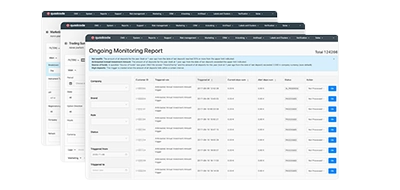Back
Contents
What is Market Order?

Demetris Makrides
Senior Business Development Manager

Iva Kalatozishvili
Business Development Manager
In essence, a market order is a simple trading order that directs the broker or exchange to buy or sell an asset as quickly as possible at the best current price. Market orders are performed quickly and easily, which is understood and valued by traders. However, it does not provide control over the exact price at which the trade is completed.
How Market Order Works
When you choose to execute a market order, your order is executed in real-time at the current market price point, without any delay or hesitation. In volatile or unpredictable markets, where market orders value speed more than price accuracy, the final price of execution can fluctuate.
Executing a market order would include buying a company’s stock at the highest possible price, for instance. However, if you choose to sell your shares instead, a market order would take into account the maximum price another buyer is ready to pay right now and sell your shares at that price.
In markets with liquidity and numerous buyers and sellers present in the market at the same time typically results in a market order filling close to the last price at which a trade occurred previously.The execution price of your order may vary significantly from the displayed price when you place your order in markets, with liquidity. This variance is called “slippage” and can occasionally result in trading results especially when market conditions are volatile.
When to Use a Market Order
Market orders work well when your main goal is to make a trade without worrying about the precise price point involved in the transaction. This approach is especially handy in the situations described below.
If you have to open or close a position or want to immediately enter a position – maybe because of sudden market changes or breaking news – using a market order ensures that your trade is carried out promptly and you get in or out of the market immediately. This is perhaps the biggest benefit of a market order. In a scenario where a stock is quickly increasing in value because of a good earnings report being released, a market order ensures that you can purchase the stock away and benefit from the upward trend before prices increase even more.
Concerns and worries about missed trading opportunities can be alleviated by opting for a market order instead of a limit order; this essentially guarantees immediate participation in the market. In situations where prices are moving swiftly and unpredictably, limit orders may not be fulfilled if the market does not reach your specified price level. As a result, limit orders could make you miss out on trading chances. When you place a market order you can sidestep this risk as the trade will go through as long as there is enough liquidity and buyers or sellers present.
In very liquid markets like major stocks or Forex, where trading volume is high and bid-ask spreads are narrow, market orders are likely to be filled very close to the current market price, indicating little difference between what a buyer is willing to pay and what a seller is looking for in return, which often leads to market orders getting executed at prices very similar to the last traded price, thus reducing any potential slippage effects. Market orders are considered as the best option for those traders who seek to swiftly enter or exit positions and are not concerned about some slippage occuring.
Downsides of Using Market Orders
Using market orders for trading provides quick and with certain execution, but also comes with drawbacks in unpredictable or less active markets. The lack of flexibility in setting pricing is a big drawback. There are no assurances about the exact price you will get when placing a market order; instead, you are committing to trade at the present market price. This strategy may lead to significant slippage and unforeseen consequences in markets where prices can change quickly within minutes.
If you decide to buy a stock at the market rate when its price is rapidly increasing and the order takes some time to process before getting filled, you might have to pay a higher amount than what you initially expected due to the continuous rise in price during that period.
Another drawback of using market orders is the possibility of partially filling orders in markets with limited liquidity levels. In situations when there are insufficient buyers or sellers available at the current price point to fill your whole order, your order may be processed in segments, with each segment possibly being completed at a different price. This fragmented execution can lead to increased trade costs and pose challenges in achieving your intended average price target. When you decide to sell an amount of shares in a stock in a market with low trading activity using a market order, some of your shares may sell at the existing bid price while the remaining might be sold at decreasing prices as you run out of interested buyers on the market.
Moreover executing market orders can pose difficulties particularly when handling sizable transactions or in times of market volatility when the conditions are uncertain. In a fast-paced market environment, the eventual price at which the trade is executed may deviate significantly from your initial anticipation posing a challenge in strategic trade planning. This unpredictability can prove troublesome for traders who depend heavily on specific entry and exit points to effectively mitigate their risks and meet their profit objectives. Henceforth, even though market orders provide the advantage of immediate and guaranteed execution, they demand thoughtful evaluation of the potential dangers, especially regarding price fluctuations and incomplete executions.
Effective Strategies for Using Market Orders
When you decide to use market orders in trading, it’s important to consider some practical aspects to make sure they work effectively. Firstly, evaluating the market conditions is crucial before placing a market order. By understanding the volatility and liquidity of the market ,you can estimate the likelihood of price slippage. Decide if a market order fits your trading plan. The possibility of slippage, or the possibility that your order will be executed at a price that differs much from what you anticipated, is higher in very volatile markets where prices fluctuate quickly. Consider if another kind of order would provide you more control over the fill price, rather than a market order, in this situation.
When trading with market orders, in order to handle risks better, it’s beneficial to use them together with stop loss orders. A stop loss order triggers a sale of your assets once the market shifts unfavorably past a level that you set, thus restricting potential losses. By using a market order along with a stop loss, you can guarantee execution of your trade and also safeguard your trade from substantial negative price swings.
Bottom Line
A market order is a fundamental trading instrument that provides fast and reliable execution, making it perfect for traders who need to take action quickly in the market. While it lacks the price control that limit orders provide, its simplicity and efficiency make it a favored option in many trading settings. The skill lies in knowing the right timing and method to apply market orders effectively to enable traders to capitalize on market shifts with assurance that their trades will go through promptly.
Updated:
December 19, 2024
8 December, 2025
How to Create an Online Casino Platform in 2026
The online casino market reached $19 billion in 2024 and, therefore, will present a massive opportunity for business owners in 2026. More than 60% of online gamblers now prefer mobile options to access digital gambling platforms, which can be attributed to increased internet and mobile use. Moreover, experts forecast a 12.2% annual growth through 2030, […]




